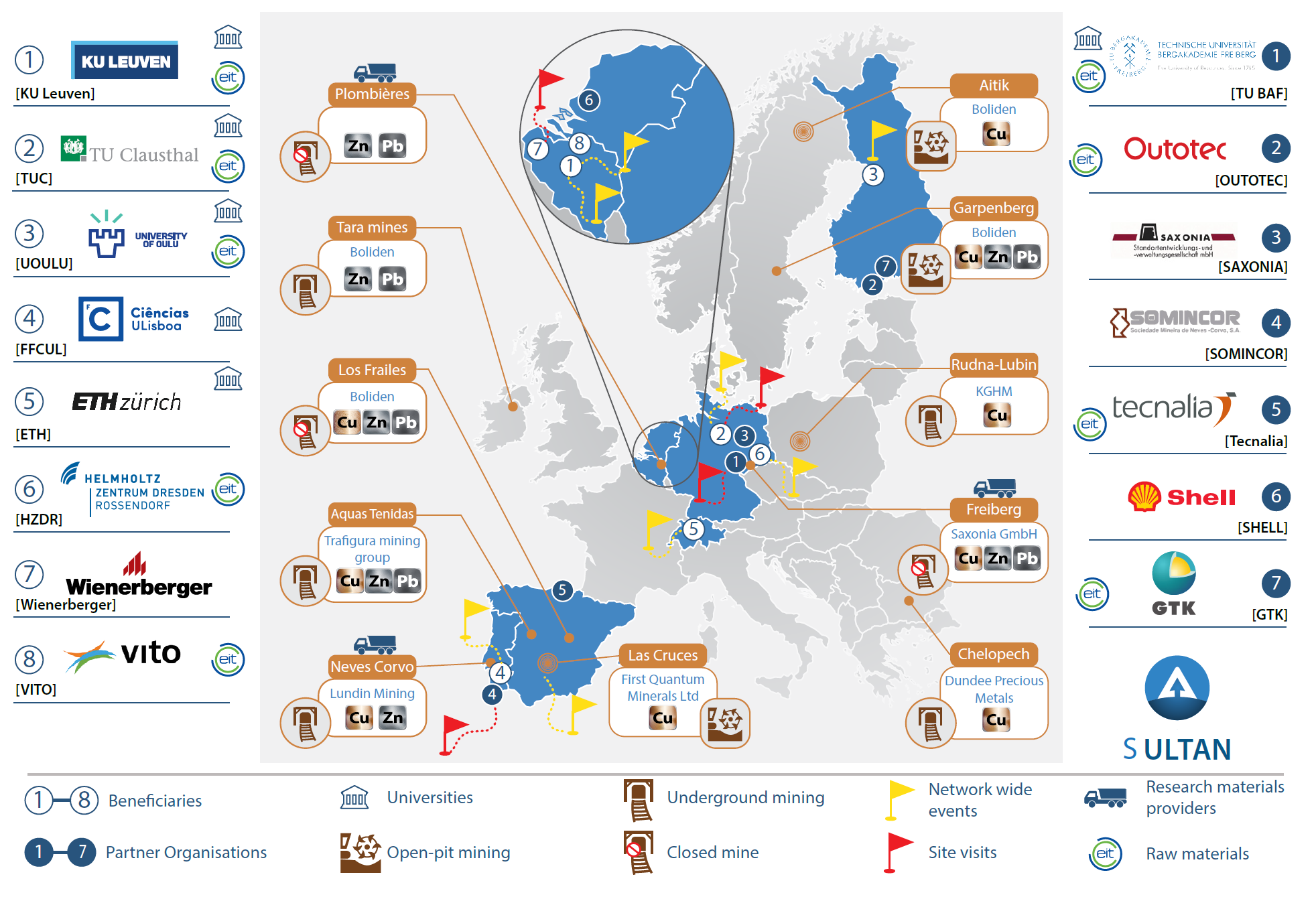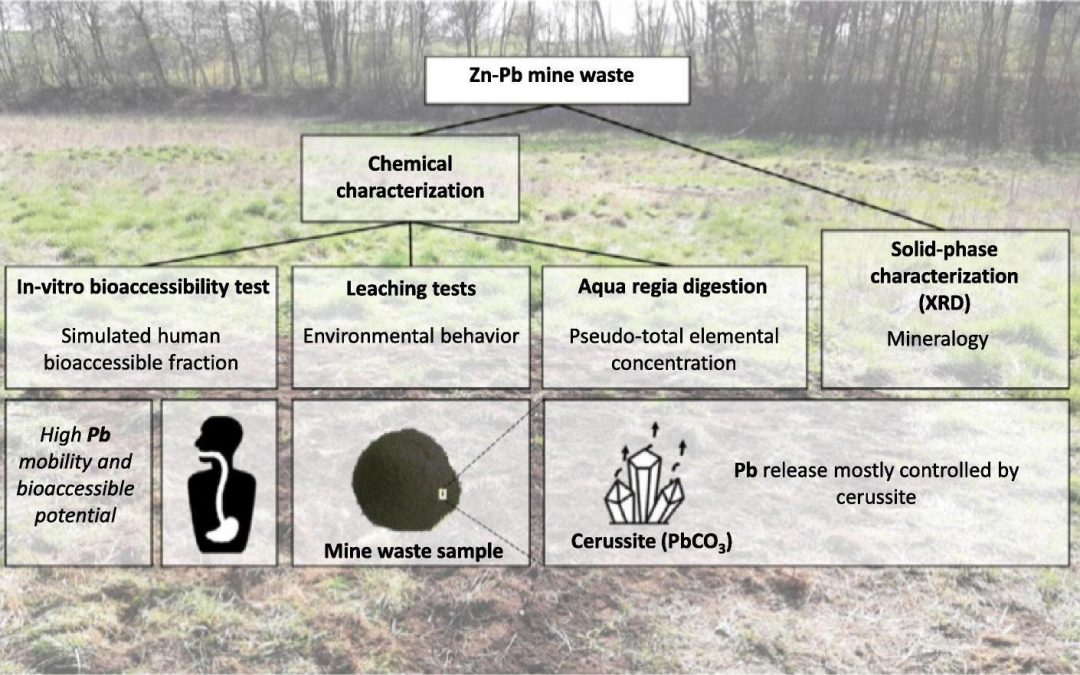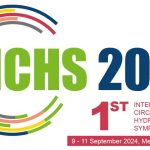SIM² KU Leuven researchers have assessed the chemical and mineralogical characterisation of sulphidic mine waste to understand the environmental and health risks of the metal(loid)s within the mine waste. The work, which was published in the Journal of Geochemical Exploration, was performed in the framework of the H2020 MSCA-ETN SULTAN project for the remediation and reprocessing of sulphidic mining waste sites.
Environmental and health risks associated with mine waste
Mine waste can be a potential concern, as proper storage of mine waste requires abundant space and, if poorly managed, it can cause environmental degradation and human health related risks. One of the major environmental risks posed is the acidification (acid mine drainage) and contamination of soil and water especially in the case of sulphidic mine waste.
In Europe there are many historical mine waste sites that date back to the start of industrial mining or even earlier. The former Pb-Zn mining site at Plombières, situated in Eastern Belgium along the Guel river, is just one example.
While the mining site at Plombières has been transformed into a public nature reserve, there are still hazardous substances present on site. The mining waste can still pose a potential threat to the environment and surrounding community, even centuries after the mining activities have ceased.
Investigation of the solid-phase speciation of metal(loid)s linked to chemical leaching (Download paper here)
To determine the potential threat that the present mine waste poses, this research team performed a detailed mineralogical and chemical characterisation revealing the potential waste management methods.
In this paper, leaching studies, an in-vitro bioaccessibility test, and mineralogical analysis coupled with geochemical modeling were used to determine the environmental and health risks of the mine waste.
Mineralogy and pH are key parameters influencing leaching
An increased leaching of Zn, Pb, Cd, and Cu were observed as pH decreased (pH < 6). This high release of As, Cu, Cd, Pb and Zn under acidic conditions is due to both the dissolution of minerals and desorption. Additionally, there was also an increased release of certain metal(loid)s (e.g., As, Pb, and Cu) at higher pH values (pH > 8).
This study also confirmed through experimental data as well as geochemical modeling that the dissolution of the Pb carbonate mineral, cerussite, was a controlling factor in the release of Pb under various conditions.
Since acid mine drainage can be an issue with sulphidic mine waste, it is imperative to understand how the metal(loid)s in the present waste would behave when exposed to these highly acidic environments.
Abundant and mobile concentrations of metal(loid)s
Although the mining site has been inactive for over 100 years, the high concentrations of metal(loid)s within the samples are still evident. Not only are the metal(loid)s present in high concentrations, but also as mobile forms, especially when pH changes.
This study proved to be critical in understanding the different parameters controlling metal(loid)s and in identifying the potential threats the mine waste poses to human health and the environment.
Based on this overall assessment, further research within the SULTAN project will focus on proper methods for an effective recovery of metals and/or reprocessing of the mine waste into green construction materials (i.e., geopolymers, green cement, and ceramics).
Full reference of paper
Jillian Helser, Valérie Cappuyns, Trace elements leaching from Pb-Zn mine waste (Plombières, Belgium) and environmental implications, Journal of Geochemical Exploration, 2021. [Download paper here]
Acknowledgements
This project has received funding from the European Union's EU Framework Program for Research and Innovation H2020 under Grant Agreement No 812580.
More info about the SULTAN project
The European Innovation Partnership (EIP) on Raw Materials launched a “call to arms” to transform the “extractive-waste problem” into a “resource-recovery opportunity”. Additionally, the EIP has warned about the acute shortage of talent in this sector. In order to develop a highly skilled workforce, to mitigate environmental risks and to economically recover valuable raw materials, the ETN for the remediation and reprocessing of sulphidic mining waste sites (SULTAN) provides the first-ever training programme dedicated to the reprocessing of tailings. SULTAN has pooled the interdisciplinary and intersectoral expertise of leading EIT RawMaterials members, world-leading mining and chemical companies, covering all the links in the tailings-reprocessing value chain.
SULTAN develops cutting-edge methodologies to assess the resource potential of Europe’s main tailings families (WP1) and explores eco-friendly mining chemicals to be used in advanced metal-extraction/recovery set-ups (WP2). SULTAN not only recovers the metals but also valorises the clean(ed) tailing residues in circular-economy applications, incl. inorganic polymers, green cements and ceramics (WP3). In WP4 a novel environmental assessment methodology is developed. The 15 SULTAN ESRs also benefit from a unique soft-skills training programme (WP5) and maximise the impact of their research through dissemination and exploitation (WP6). This will kick-start their careers as highly employable professionals in the EU’s tailings reprocessing/remediation sector, as well as for geological surveys, teaching and scientific organisations, and public bodies.
Website: https://etn-sultan.eu/







